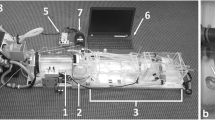Abstract
We aimed to obtain high-stable computed tomography (CT) values for CT angiography (CTA). We verified the optimal use of the new protocol for long-range scanning using a contrast material flow phantom (Ichikawa, CT imaging theory. Igaku syoin Publishing, Tokyo, 8; Awai et al., Am J Roentgenol 186(2):379–385, 1) to obtain high-stable CT values (Fig. 2). We have developed a novel contrast injection method called the stable line imaging protocol (SLIP). This method involved a gradual reduction in the rate of administration of the contrast medium, which was accompanied by simultaneous administration of saline to compensate for the resultant decrease in the rate of administration. A saline flush was further added after the contrast medium injection. The rate of administration of the saline flush was the same as that of the initial contrast medium. We injected a contrast medium from the injector into the flow phantom. The time-enhancement curve (TEC) data were obtained five times by changing the injection method, and the average CT values were determined. The maximum simulation of the aortic peak enhancement of TEC was defined as pTEC. The time required to keep the CT value more than 80% of the pTEC was defined as the time period of contrast enhancement (p80). The pTEC of a single injection was 295.7 ± 5.3 HU, while that of SLIP was 296.5 ± 2.3 HU; the two values did not differ significantly. The p80 of a single injection was 19.1 ± 0.2 s, while that of SLIP was 23.2 ± 0.4 s; p80 of SLIP was 18% longer than that of the single injection.












Similar content being viewed by others
References
Awai K, Hatcho A, Nakayama Y, Kusunoki S, Liu D, Hatemura M, Yamashita Y, et al. Simulation of aortic peak enhancement on MDCT using a contrast material flow phantom: feasibility study. Am J Roentgenol. 2006;186(2):379–85.
Bae KT. Intravenous contrast medium administration and scan timing at CT: considerations and approaches 1. Radiology. 2010;256(1):32–61.
Behrendt FF, Bruners P, Keil S, Plumhans C, Mahnken AH, Das M, Mühlenbruch G, et al. Effect of different saline chaser volumes and flow rates on intravascular contrast enhancement in CT using a circulation phantom. Eur J Radiol. 2010;73(3):688–93.
Behrendt FF, Jost G, Pietsch H, Keil S, Mottaghy FM, Günther RW, Mahnken AH. Computed tomography angiography: the effect of different chaser flow rates, volumes, and fluids on contrast enhancement. Invest Radiol. 2011;46(4):271–6.
Cameron JR, Skofronick JG, Grant RM. Physics of the body. 2nd ed. Madison: Medical Physics; 1999.
Fleischmann D. CT angiography: injection and acquisition technique. Radiol Clin N Am. 2010;48(2):237–47.
Hudson DM. Top shelf human anatomy & physiology. J Weston Walch Publishing; 2006.
Ichikawa T. CT imaging theory. Tokyo: Igaku syoin Publishing; 2004.
Kim T, Murakami T, Takahashi S, Tsuda K, Tomoda K, Narumi Y, Nakamura H, et al. Effects of injection rates of contrast material on arterial phase hepatic CT. AJR Am J Roentgenol. 1998;171(2):429–32.
Lu JG, Lv B, Chen XB, Tang X, Jiang SL, Dai RP. What is the best contrast injection protocol for 64-row multi-detector cardiac computed tomography? Eur J Radiol. 2010;75(2):159–65.
Marin D, Nelson RC, Guerrisi A, Barnhart H, Schindera ST, Passariello R, Catalano C. 64-section multidetector CT of the upper abdomen: optimization of a saline chaser injection protocol for improved vascular and parenchymal contrast enhancement. Eur Radiol. 2011;21(9):1938–47.
Takeyama N, Kuroki K, Hayashi T, Sai S, Okabe N, Kinebuchi Y, Gokan T, et al. Cerebral CT angiography using a small volume of concentrated contrast material with a test injection method: optimal scan delay for quantitative and qualitative performance. Br J Radiol. 2012;85(1017):e748.
Tatsugami F, Matsuki M, Inada Y, Nakai G, Tanikake M, Yoshikawa S, Narabayashi I. Usefulness of saline pushing in reduction of contrast material dose in abdominal CT: evaluation of time–density curve for the aorta, portal vein and liver. Br J Radiol. 2007;80:231–4.
Tomizawa N, Suzuki F, Akahane M, Torigoe R, Kiryu S, Ohtomo K. Effect of saline flush on enhancement of proximal and distal segments using 320-row coronary CT angiography. Eur J Radiol. 2013;82(8):1255–9.
Yamaguchi I, Kidoya E, Suzuki M, Kimura H. Optimizing scan timing of hepatic arterial phase by physiologic pharmacokinetic analysis in bolus-tracking technique by multi-detector row computed tomography. Radiol Phys Technol. 2011;4(1):43–52.
Author information
Authors and Affiliations
Corresponding author
Ethics declarations
Conflict of interest
The authors declare that they have no conflicts of interest.
Ethical standards
All procedures performed in studies involving human participants were in accordance with the ethical standards of the institutional and/or national research committee and with the 1964 Helsinki Declaration and its later amendments or comparable ethical standards.
Informed consent
For this type of study formal consent is not required.
Human/animal rights
All applicable international, national, and/or institutional guidelines for the care and use of animals were followed. This article does not contain any studies with human participants or animals performed by any of the authors.
About this article
Cite this article
Yamaguchi, A., Sasaki, T. Optimal injection method for long-range computed tomography angiography. Radiol Phys Technol 10, 301–310 (2017). https://doi.org/10.1007/s12194-017-0402-9
Received:
Revised:
Accepted:
Published:
Issue Date:
DOI: https://doi.org/10.1007/s12194-017-0402-9




